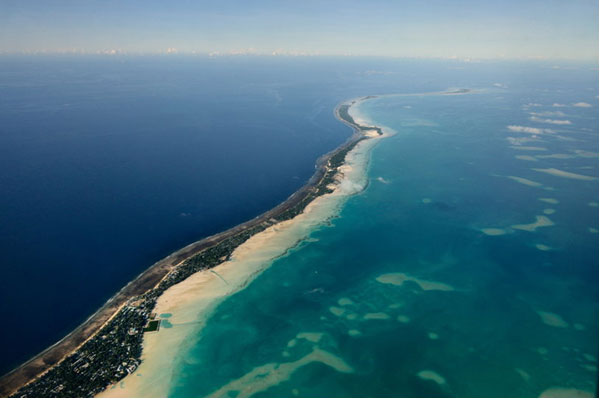
New Delhi: Sea level rise is happening now, and the rate at which it is rising is increasing every year, thanks to ongoing melting of ice sheets in both Antarctica and Greenland; according to a study released in the Proceedings of the National Academy of Sciences.
Researchers led by University of Colorado-Boulder professor of aerospace engineering sciences Steve Nerem, used satellite data dating to 1993 to observe the levels of the world's oceans rather than tide-gauge data that is normally used to measure sea levels allows for more precise estimates of global sea level, since it provides measurements of the open ocean.
The team observed a total rise in the ocean of 7 centimetres (2.8 inches) in 25 years of data, which aligns with the generally accepted current rate of sea level rise of about 3 millimetres (0.1 inches) per year.
But that rate is not constant. Continuous emissions of greenhouse gases are warming the Earth's atmosphere and oceans and melting its ice, causing the rate of sea level rise to increase.
At the current rate of melting, the world's seas will be at least 2 feet higher by the end of the century compared to today, according to research published in the Proceedings of the National Academy of Sciences.
Such a rise could leave portions of the world’s coastal cities underwater. It would also increase high tides and worsen storm surges.
"This acceleration, driven mainly by accelerated melting in Greenland and Antarctica, has the potential to double the total sea level rise by 2100 as compared to projections that assume a constant rate, to more than 60 centimetres instead of about 30," said Nerem, who is also a fellow with the Cooperative Institute for Research in Environmental Science.
That projection agrees perfectly with climate models used in the latest International Panel on Climate Change report, which show sea level rise to be between 52 and 98 centimetres by 2100 for a ‘business as usual’ scenario (in which greenhouse emissions continue without reduction).
Therefore, scientists now have observed evidence validating climate model projections, as well as providing policy-makers with a ‘data-driven assessment of sea level change that does not depend on the climate models,’ Nerem has said.
Sea level rise of 65 centimetres, or roughly 2 feet, would cause significant problems for coastal cities around the world. Extreme water levels, such as high tides and surges from strong storms, would be made exponentially worse.
“Sixty-five centimetres is probably on the low end for 2100,” Nerem said, since it assumes the rate and acceleration we have seen over the last 25 years continues for the next 82 years.
The researchers used data from other scientific missions such as GRACE, the Gravity Recovery and Climate Experiment, to determine what was causing the rate to accelerate.
Currently, over half of the observed rise is the result of "thermal expansion": As ocean water warms, it expands, and sea levels rise. The rest of the rise is the result of melted ice in Greenland and Antarctica and mountain glaciers flowing into the oceans.
Theirs is a troubling finding when considering the recent rapid ice loss in the ice sheets.
“We are already seeing signs of ice sheet instability in Greenland and Antarctica, so if they experience rapid changes, then we would likely see more than 65 centimetres of sea level rise by 2100.”
Penn State climate scientist Michael Mann, who was not involved with the study, said “It confirms what we have long feared: that the sooner-than-expected ice loss from the west Antarctic and Greenland ice sheets is leading to acceleration in sea level rise sooner than was projected.”
Damaging Potential
Rising sea levels are widely considered to be the greatest threat posed by climate change. They threaten low-lying countries with inundation, forcing inhabitants to migrate. Coastal cities and ports could be flooded, as could cities sited near tidal estuaries, like London. Many nuclear installations are built by the sea so they can use sea water for cooling.
The potential for sea level rise is enormous. This is because the ice caps - Greenland and Antarctic - contain huge amounts of fresh water - around 70% of all the freshwater on Earth. Estimates suggest that if the Greenland ice sheet was to melt away to nothing, sea levels would rise around 6 metres. To put that a different way, a loss of just one per cent of the Greenland ice cap would result in a sea level rise of 6cm.
If the West Antarctic Ice Sheet (WAIS) were to melt, this would add around 6 metres to sea levels. If the East Antarctic Ice Sheet (EAIS) were to melt as well, seas would rise by around 70 metres.
In a process that is accelerating, all three ice caps are losing mass. While nobody is suggesting any of the ice caps will melt away to nothing, only a small amount of melting would cause great problems.
A 1% loss of ice from these three sources would produce a likely increase in sea levels of around 76cm. With the thermal expansion implied by such melting, and contributions from melting glaciers, the oceans would actually rise far more.
This way the research already has created a buzz in the community of scientists studying Antarctic.
Although this research is impactful, the authors consider their findings to be just a first step. The 25-year record is just long enough to provide an initial detection of acceleration -- the results will become more robust when the subsequent altimetry satellites lengthen the time series.
Ultimately, the research is important because it provides a data-driven assessment of how sea level has been changing, and this assessment largely agrees with projections using independent methods.
Future research will focus on refining the results in this study with longer time series, and extending the results to regional sea level, so they can better predict what will happen in your backyard.
References:
https://www.usatoday.com
https://edition.cnn.com
https://www.skepticalscience.com